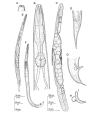
. Rhabditophanes schneideri A, Lip region. B, Pharyngeal
region. C, Female gonad.
D, Female posterior. E, Female. F, Male. G, Male posterior H,
Gubernaculum. I, Spicule.
From Seddiqi et al., 2016
|
|
|
Male:
- Body curved ventrally, “Jâ€-shaped after fixation.
- Monorchic, with testis ventrally reflexed.
- Three precloacal pairs of gental papillae and five postcloacal
pairs, two subventral and three subdorsal.
- Spicules ventrally curved, shorter than cbd; manubrium rounded,
offset from short calomus; lamina ventrally curved and weakly
developed velum.
- Gubernaculum with a proximal globular part.
- Tail conical, curved ventrad, with slender terminal spike.
Phasmids at 46% of tail length.
Ref: Seddiqi et al., 2016
|
Female:
- Body slightly curved ventrad after fixation. Cuticle striated,
lateral fields not visible.
- Lip region offset, with six rounded lips, bearing small
papillae.
- Stoma panagrolaimoid, with distinct cheilo-, gymno- and
stegostom;
- Pharynx rhabditoid; pharyngeal corpus about 2.5-3.5 times the
isthmus length, distinctly swollen; isthmus robust, wider anteriorly
and distinctly separated from corpus; basal bulb spheroid, with
prominent grinder.
- Cardia conoid, surrounded by intestinal tissue.
- Nerve ring at isthmus level, secretory-excretory pore opening at
isthmus level,
- Didelphic-amphidelphic; ovaries dorsally reflexed, lacking
posterior flexures; oviduct long, tubular, separated from the uterus
by a constriction;
- Sspermatheca not differentiated; uteri swollen, each twice as
long as the corresponding body diameter; vagina with thin walls,
one-third of the body diameter long;
- Vulva with slightly protruding lips, located posterior to middle
part of body.
- Rectum 1.3 times the abd.
- Tail conical, slightly concave ventrally with acute end.
Phasmids at 34% of tail length.
|